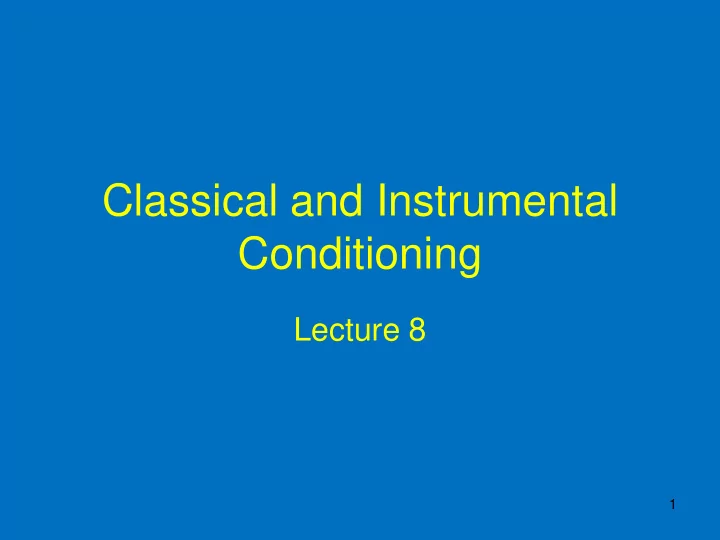

Classical and Instrumental Conditioning Lecture 8 1
Basic Procedure for Classical Conditioning CS US (Bell) (Meat Powder) UR CR (Salivation) (Salivation) 2
Major Phenomena of Classical Conditioning • Acquisition – CR to CS Reinforced by US – Response Gains Strength • Magnitude of CR • Probability of CR 3
Acquisition: Trial 1 Bell CS Food US Drops of CR Saliva Time 4
Acquisition: Trial 5 Bell CS Food US Drops of CR Saliva Time 5
Acquisition: Trial 10 Bell CS Food US Drops of CR Saliva Time 6
Acquisition of a Conditioned Response CS ==> US 1 Probability of CR 0.8 Positive Acceleration 0.6 Negative Acceleration 0.4 0.2 The “Sigmoidal” (S-Shaped) Learning Curve is Also Known as an Ogive 0 1 2 3 4 5 6 7 8 9 10 11 12 Trials 7
Two Shapes to the Learning Curve Naïve Organism/ Experienced Organism/ Complex Behavior Simple Behavior Response Strength Response Strength 1 2 3 4 5 6 7 8 9 10 11 12 13 14 15 1 2 3 4 5 6 7 8 9 10 11 12 13 14 15 Trials Trials 8
Major Phenomena of Classical Conditioning • Acquisition • Extinction – No Reinforcement – Response Loses Strength 9
Extinction: Trial 1 Bell CS Food US Drops of CR Saliva Time 10
Extinction: Trial 5 Bell CS Food US Drops of CR Saliva Time 11
Extinction: Trial 10 Bell CS Food US Drops of CR Saliva Time 12
Extinction of a Conditioned Response CS ==> No US 1 Probability of CR 0.8 0.6 0.4 0.2 0 1 2 3 4 5 6 7 8 9 10 11 12 Trials 13
Major Phenomena of Classical Conditioning • Acquisition • Extinction • Spontaneous Recovery – Rest After Extinction – Retest CS alone 14
Spontaneous Recovery After Extinction CS ==> No US Extinction Acquisition 1 Probability of CR 0.8 Spontaneous Recovery 0.6 0.4 Further Extinction 0.2 (Rest) 0 Trials 15
Re-Acquisition of Extinguished Response CS ==> US Acquisition Extinction Re-Acquisition 1 0.8 Probability of CR Savings in Relearning 0.6 0.4 Spontaneous Recovery 0.2 (Rest) 0 Trials 16
Extinction Below Zero • Extinction Trials Continued After CR Disappears Entirely • Reduced Spontaneous Recovery • Less Savings in Relearning – Slower Reacquisition 17
Major Phenomena of Classical Conditioning • Acquisition • Extinction – Extinction Below Zero • Spontaneous Recovery • Re-Acquisition – CS Reinforced by US – Savings in Relearning 18
Implications of Savings and Spontaneous Recovery • Conditioned Response Not “Lost” • Rather, Inhibited or Suppressed – In Line with Changing Circumstances • Conditioned Stimulus No Longer Reinforced • CR Can be Dis inhibited – In Line with Changing Circumstances • CS Reinforced Once Again 19
Major Phenomena of Classical Conditioning • Acquisition • Extinction • Spontaneous Recovery • Re-Acquisition • Generalization – CS 0 vs. CS 1 …CS n – Generalization Gradient 20
The Generalization Gradient 250cps 1 0.9 Probability of CR 0.8 200cps 300cps 0.7 Lower Higher 0.6 0.5 150cps 350cps 0.4 Original 0.3 CS 0.2 0.1 0 -5 -4 -3 -2 -1 0 1 2 3 4 5 Test Stimulus 21
Major Phenomena of Classical Conditioning • Acquisition • Extinction • Spontaneous Recovery • Re-Acquisition • Generalization • Discrimination – CS+ (Reinforced) – CS- (Unreinforced) 22
Discrimination Learning CS+ ==> US CS- ==> No US 1 250 cps Probability of CR 0.8 0.6 CS+ CS- 0.4 200 cps 0.2 0 1 2 3 4 5 6 7 8 9 10 11 12 Trials 23
Review of Classical Conditioning • Vocabulary • Phenomena – Unconditioned Stimulus – Acquisition • Reinforcement – Unconditioned Response – Extinction – Conditioned Stimulus – Spontaneous Recovery – Conditioned Response – Savings in Relearning – Generalization • Generalization Gradient – Discrimination 24
Sensory Preconditioning Light CS1 1 CS2 Bell CS2 Bell 2 US Food CR Saliva CS1 Light 3 CR Saliva 25
Higher-Order Conditioning CS1 Bell 1 US Food CR Saliva CS2 Light 2 CS1 Bell CS2 Light 3 CR Saliva 26
Significance of Classical Conditioning • Extends Control of Reflexes to Other Environmental Events – Associations between Events • Ubiquitous (Nervous System) • Pavlov: All Learning is Classical Conditioning (?) • Laws of Classical Conditioning are the Laws of Emotional Life 27
Thorndike’s Puzzle Box 28
Thorndike’s Results 29
Thorndike’s Laws of Learning Law of Readiness Law of Effect Law of Exercise 30
Instrumental Conditioning ( Operant Conditioning) • Learn Adaptive Behavior – Through Experience of Success, Failure • Organism Operates on Environment – Behavior Changes Environment • Behavior Instrumental – Obtains Desired State of Affairs • Associations between Behaviors and Outcomes 31
B.F. Skinner’s Operant Chamber 32
Instrumental Conditioning Procedure • Phase 1: Baseline Behavior • Phase 2: Acquisition Phase • Phase 3: Discrimination Learning • Phase 4: Extinction 33
Vocabulary of Instrumental Conditioning • Conditioned Response (No URs) • Conditioned Stimulus (No USs) • Reinforcement – Positive – Negative (Not Punishment) • Acquisition • Extinction • Generalization • Discrimination 34
Schedules of Reinforcement • Continuous • Partial • Intermittent – Fixed Ratio (FR) – Variable Ratio (VR) – Fixed Interval (FI) – Variable Interval (VI) • Differential Reinforcement – Of Low Rates (DRL) – Of High Rates (DRH) 35
Intermittent Reinforcement 36
The Matching Law Herrnstein (1970) • Concurrent VI Schedules – Give Organism a Choice • Key A: VI3 • Key B: VI1 • Response Rate is Proportional to the Frequency of Reinforcement – Also Magnitude, Delay of Reinforcement • Basic Principle of Microeconomics – Supply and Demand • Relative Value of Reinforcers 37
Significance of Instrumental Conditioning • Voluntary Behaviors Come Under Control of Environmental Events – Behavior-Outcome Associations • Ubiquitous (Vertebrates) • Thorndike, Skinner: All Learning is Instrumental/Operant Conditioning (?) • Laws of Instrumental Conditioning Are the Laws of Adaptive Behavior – Habits – Incentives 38
Recommend
More recommend